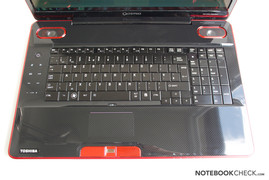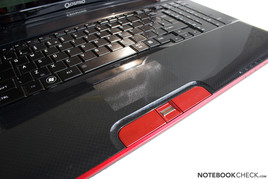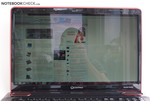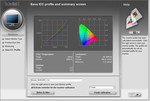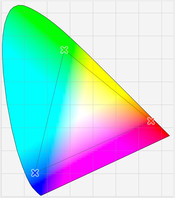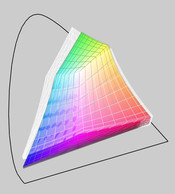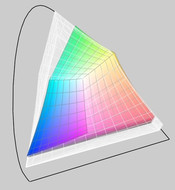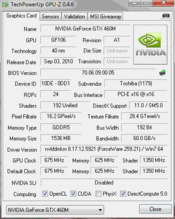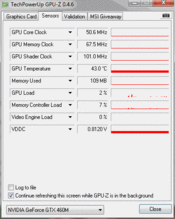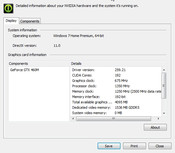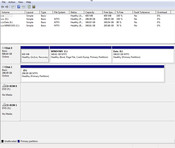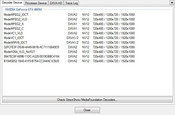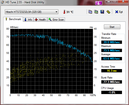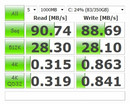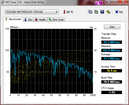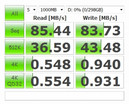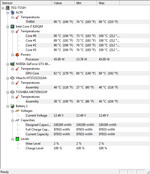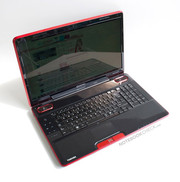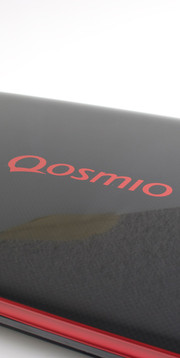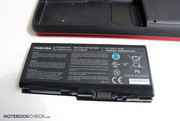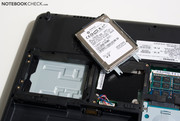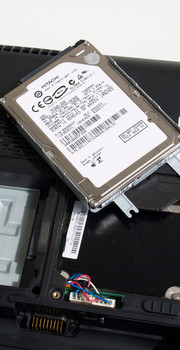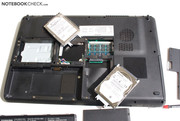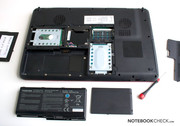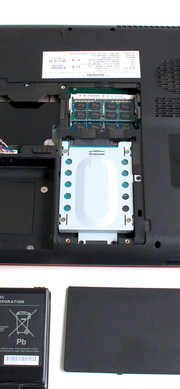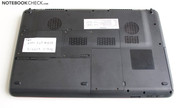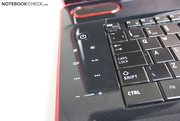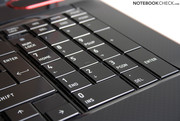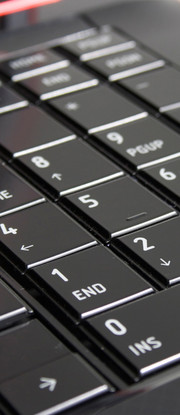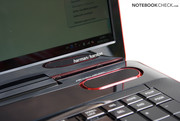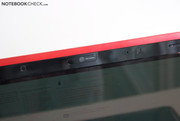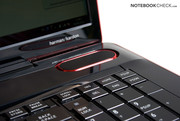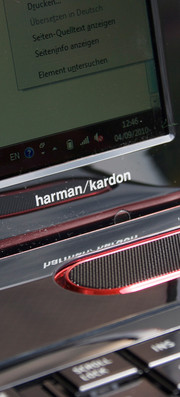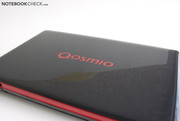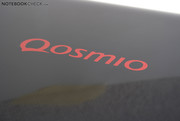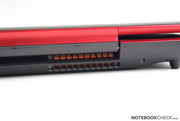Review Toshiba Qosmio X500 Notebook (GeForce GTX 460M)

"A gamer can't have enough power" - is stated on Toshiba's German homepage. In the same breath, it heralds the Qosmio X500 as the "perfect gaming machine". The specifications appear to be a bit obsolete. The Nvidia GTS 250M graphics card in the device had already been replaced by the stronger GTS 360M graphic chip at the beginning of the year.
The notebook couldn't really join the gamers' top-class even with this configuration. Devices with a GTX 280/285M or HD 5870, the first choice for gamers until now, remained out of reach for the Toshiba notebook.
This could be a thing of the past, now that Nvidia has launched a new graphics card family, based on the Fermi architecture. Toshiba equips the Qosmio X500-TZ1V with a Geforce GTX 460M graphics card. Thus, it infiltrates the highest performance class in the comparison of mobile graphics cards.
As you can see on the English keyboard, the TZ1V is probably not conceived for the German market. The slightly differently named X500 -3R, 13P and 148 models with a GTX460M can however already be found on price comparison sites.
Read where the notebook positions itself in comparison to other gaming machines and how far the previous models fall behind in the following review.
Case
We've already had two Qosmio X500 alternatives in our test lab. There was the X500-10V with a somewhat weak GTS 250M graphics (not least because of the used GDDR3 memory) late last year. About half a year later, a remake with a beefed up GTS 360M graphics followed. It could present a significant performance boost, but not hold a candle to the gaming elite anyway. The new GTX 460M is now to catch up again and bring Toshiba a step closer to the gaming fan community.
Common for all alternatives is the bulky 18 inch case with a strikingly colorful look that Toshiba calls "Fusion Finish". The combination of red and black elements has to be described as very attractive. However, it clearly reveals the notebook's gaming intentions.
The reflective, high-gloss surfaces, common for this category, have a certain appeal when just unpacked. But they are likely to be covered by fingerprints and very visible dust particles after a few days of use. Merely the Asus G73 represents a praiseworthy exception here.
As to the notebook's stability, the Qosmio X500 has an easy job due to its huge size. The base unit skillfully wards off applied pressure. Merely the display shows weaknesses in this regard. The display isn't convincing with the audible squeaking and creaking noises when the opening angle is changed, either.
Connectivity
In comparison to the previous models, there haven't been any changes made in terms of given interfaces. The ports' positioning more towards the sides' back is positive. Among others, a USB/eSATA combo port is available. You still have to do without USB 3.0 for the time being.
The HDMI-CEC (High Definition Multimedia Interface - Consumer Electronics Control) port is worth mentioning. This port allegedly allows home entertainment devices to be controlled with one single remote control. Further tests haven't been made in this regard, though. Supplementary information can be found directly at Toshiba.
Communication
The Toshiba bids everything that a gamer needs in terms of communication. It's equipped with LAN, WLAN 802.11 bgn (Realtek RTL8187SE) and Bluetooth. The installed HD webcam (1280x800) also allows video transmission for video telephony.
Supplies
You'll, for example, find WinDVD Blu-Ray Disk Edition pre-installed on the notebook. Compatible software for upscaling DVDs is also included. Toshiba promises that it makes it possible to "upconvert" common DVDs and thus enhance the video quality.
Even if the Qosmio X500 most certainly doesn't earn the label "green", the power consumption can be improved with the Toshiba Eco Utility. Additionally, it can be monitored with the integrated visualization.
Toshiba's "Reel-Time" software, which visualizes recently edited documents, is also worth mentioning.
Warranty
Toshiba offers a two year international bring-in manufacturer warranty for the Qosmio X500, which includes on-site pickup by registering the repair at Toshiba's Notebook Hotline.
Input Devices
Keyboard
Toshiba embeds a backlit keyboard into the Qosmio X500. The keyboard unit fits sufficiently tight in the case and doesn't clatter. However, a slight curve of the entire keyboard towards the user was seen on our test device. The key size turns out to be very generous, with exception of the space bar. The single keys' absolutely smooth surface needs getting used to. It makes orientation difficult when typing on the unit. More information about the keyboard can be found in the review of the predecessor, X500-10V.
Touchpad
The incorporated touchpad turns out rather small in relation to the bulky 18 inch case. The touchpad surface's gliding traits are alright. It can easily be disabled by a dedicated button, since the pad principally won't be of much importance for gamers.
Display
Toshiba obviously uses the same screen as we already had in the reviewed version, X500-10V. The screen isn't able to amaze us with a maximum brightness of only just 166.6 cd/m2 in the central display area.
Even otherwise, the subjective impression of the screen is once again very weak. The display is visibly color cast and reflects very intensely. This is probably also because of the only average brightness. The high Full-HD resolution (1920x1080 pixels) thus only remains as the only plus point.
There is an alternative display with a lower resolution available, which we had tested in the X500-121. If it will also be offered for the new GTX 460M isn't yet known, though.
Our assessment of the representable color spectrum shows that the screen is able to almost cover the entire sRGB color space. Thus, the display positions itself above the currently favored cheap screens, which present a considerably smaller color space. In comparison to particularly high-quality displays, such as the RGB LED display in Dell's Studio XPS 16, the Toshiba Qosmio still lags far behind. Too bad that the screen can't subjectively display the good color space.
The given viewing angle stability doesn't show any irregularities. That is, the usual somewhat larger viewing angles on the horizontal plane and color changes turning up sooner on the vertical plane at the same time. The intensifying reflections observed when deviating from the ideal viewing angle indoors are particularly annoying.
Performance
You may believe all's new in Toshiba's X500-TZ1V in view of the configuration at hand. This at least applies to the used graphics and processor. After the 720QM CPU in the previous models, Toshiba stocks up the gamer's computing heart a bit with the revamped Intel Core i7-740QM. In comparison to the previous 720QM, you now can take delight in the slightly increased clock rates of 1730 - 2930 MHz. This is very convenient for gamers because the higher clock rates in games still have a positive effect on the performance of single tracks. Further details about this can be found in our review of the updated Intel Clarksfield-CPU range.
However, the graphics update should be much more exciting for potential buyers of the Toshiba Qosmio X500's latest edition. The fairly strong Geforce GTS 360M is now replaced by the brand new Nvidia Geforce GTX 460M.
The graphics chip is based on Nvidia's newly developed Fermi architecture and attracts attention with its potent specs: 192 unified shaders, a 1536MB GDDR5 video memory tethered to 192 bits, a 675MHz core rate, a 1250 memory clock rate.
You'll read DirectX11 as well as PhysX, CUDA and DirectCompute on the graphics card's supported features list. Detailed information about Nvidia's GTX 460M can be found here.
Not only the GPU and CPU have been upgraded. Toshiba has come up with something new for the hard disk, as well. Both HDD slots in the device are already known. New is that Toshiba now installs a just as brand new 750GB hard disk from its own manufacturing for the system partition. Together with the 320GB disk in the second slot, a lavish total gross memory capacity of 1070GB, or more than one Terabyte, is the result.
| PCMark Vantage Result | 5222 points | |
Help | ||
The mere key data of the used hardware already sound very promising. But the Qosmio X500 will have to show how it looks in detail in terms of performance and where it places itself in comparison to other, current gaming machines in the benchmarks.
CPU Benchmarks
Let's start with the CPU. The test system achieves 2933 points in the Cinebench R10 (32 bit) benchmark test. This rate is significantly below that of the same CPU in the mySN XMG8.c (3107). But, it first really gets down to business for the processor in the multi-core rendering test, which demands all 8 available threads of the chip. The i7-740QM CPU achieves 8771 points here. That is a good, even if not an absolutely top rate in comparison to other test configurations. The Qosmio X500-10V with a 720QM had a much better score with 10311 points.
In the CPU test, the X500 achieves 3.2 points in the latest Cinebench R11.5 benchmark test (64 bit). Thus, it is on par with systems that also use this processor. Moreover, an advantage to the previous 720QM chip becomes clear. It scores 2.6 to 3.0 points in this test.
GPU Benchmarks
Now, we'll take a look at the used graphics card in the benchmark test. The Toshiba X500-TZ1V scores 12124 points in the well-tried 3DMark 2006 benchmark test (1280x1024). The notebook stays just behind the Asus G73JW, with the same graphics solution. Gamers with an ATI HD5850 and HD5870 graphics card, just like the GTX280/285 chips of the now obsolete graphics card generation, are in the immediate vicinity.
Our test system achieves 7517 points in the latest 3DMark Vantage. Thus, it places itself just before the Asus G73JW (7366). In comparison, the Qosmio X500 with the GTX 460M graphics impressively places itself in front of gaming machines with an HD5850, GTX280M and 285M graphics solution. Only the ATI HD5870 or various SLI solutions can score better results.
| 3DMark 2001SE Standard | 33339 points | |
| 3DMark 03 Standard | 33915 points | |
| 3DMark 05 Standard | 17886 points | |
| 3DMark 06 Standard Score | 12124 points | |
| 3DMark Vantage P Result | 7517 points | |
Help | ||
HDD Benchmarks
In any case, the huge gross memory capacity of more than one terabyte has to be noted positively. The solution with two hard disks definitely also has its advantages. For example, one hard disk can be used for backing up the other. This way the risk of data loss is reduced to a minimum.
The 750GB hard disk comes from Toshiba (MK7559GSXP) and does its work in a 2.5" case with a height of merely 9.5 millimeters. The average transfer rate of 72.5 MB/s, determined with HDTune, places itself in the upper midfield of common hard disks. The second hard disk from Hitachi (HTS723232L9A) lags a bit behind with an average of 63.6 MB/s.
We could execute extensive gaming tests on the Asus G73JW, also equipped with Nvidia's Geforce GTX 460M graphics. The Toshiba Qosmio X500's results turn out very similar.
With 47 fps (FHD, all on, max. 4xAA), Toshiba's X500 even supplied much better results than Asus' G73JW in Call of Duty - Modern Warfare. It is only a few frames away from comparison devices with ATI HD 5870 graphics (Asus G73JH: 48.7 fps).
The same applies to Battlefield - Bad Company 2. With 31 fps, rates can be achieved in highest details (FHD, very high, HBAO on, 4xAA, 8xAF), as competitors with an HD5870 graphics reach: MSI GX740 30.9 fps, Deviltech 9700 DTX DTX 33.1 fps.
You'll find the detailed benchmarks of the Toshiba Qosmio X500 with GTX 460M graphics in current and older games in the following chart. Our games list of mobile graphics cards could also be of assistance for detailed comparisons.
| low | med. | high | ultra | |
|---|---|---|---|---|
| Quake 3 Arena - Timedemo (1999) | 643 | |||
| Doom 3 (2004) | 216 | 209 | ||
| Counter-Strike Source (2004) | 138 | |||
| World of Warcraft (2005) | 81 | |||
| Quake 4 (2005) | 62 | |||
| Half Life 2 - Lost Coast Benchmark (2005) | 197 | |||
| World in Conflict - Benchmark (2007) | 165 | 66 | 62 | 27 |
| Crysis - GPU Benchmark (2007) | 92.6 | 70.2 | 52.6 | 12.9 |
| Crysis - CPU Benchmark (2007) | 112.4 | 70.4 | 58.4 | 12.2 |
| Supreme Commander - FA Bench (2007) | 54.7 | 49.2 | 48.4 | 37.2 |
| Call of Duty 4 - Modern Warfare (2007) | 83 | |||
| Trackmania Nations Forever (2008) | 317 | 86.5 | 31.7 | |
| Crysis Warhead (2008) | 76 | 25 | ||
| Far Cry 2 (2008) | 121.7 | 86.4 | 41.5 | |
| Left 4 Dead (2008) | 128 | |||
| F.E.A.R. 2 (2009) | 52 | |||
| Sims 3 (2009) | 105 | 61 | ||
| Anno 1404 (2009) | 123 | 44 | ||
| Colin McRae: DIRT 2 (2009) | 113 | 102.9 | 75.3 | 42.9 |
| Need for Speed Shift (2009) | 61 | 43 | ||
| Resident Evil 5 (2009) | 99 | 70.2 | 48.6 | |
| Risen (2009) | 31 | |||
| CoD Modern Warfare 2 (2009) | 47 | |||
| Battlefield: Bad Company 2 (2010) | 80 | 65 | 58 | 31 |
| Metro 2033 (2010) | 88 | 54 | 30 | 9 |
| StarCraft 2 (2010) | 172 | 66 | 57 | 36 |
| Mafia 2 (2010) | 53.6 | 50.2 | 46.7 | 32.9 |
Emissions
System Noise
The fan runs constantly during use without load, but always on a level with a very discreet sound characteristic.
A similar picture can be seen under load. The fan is clearly audible here, but remains at a constant level for a longer period without pulsing. The notebook's system noise is easy to handle during gaming.
Noise level
| Idle |
| 33.7 / 33.7 / 33.7 dB(A) |
| Load |
| 38.7 / 42.3 dB(A) |
 | ||
30 dB silent 40 dB(A) audible 50 dB(A) loud |
||
min: | ||
Temperature
The entire case is without significant warming in idle mode. The maximum of 41°C, measured on the upper back side, is only a selective outlier. The rest of the case only reaches rates slightly above, respectively below the 30°C mark.
The wrist-rest that is important for a comfortable use remains cool under load. However, a temperature of up to 50°C and even slightly more can be observed along the notebook's rear edge.
It also gets hot inside the notebook. The CPU temperatures climb up to 100°C in the stress test and settle to about 90°C in the long run. Even the GPU gets really hot with up to 90°C, but doesn't exceed a critical level. The 3DMark06 test executed immediately afterwards also confirmed this. It didn't show a divergent result (no throttling).
(-) The maximum temperature on the upper side is 54 °C / 129 F, compared to the average of 40.4 °C / 105 F, ranging from 21.2 to 68.8 °C for the class Gaming.
(-) The bottom heats up to a maximum of 51 °C / 124 F, compared to the average of 43.3 °C / 110 F
(+) In idle usage, the average temperature for the upper side is 30.7 °C / 87 F, compared to the device average of 33.9 °C / 93 F.
(+) The palmrests and touchpad are reaching skin temperature as a maximum (33 °C / 91.4 F) and are therefore not hot.
(-) The average temperature of the palmrest area of similar devices was 28.9 °C / 84 F (-4.1 °C / -7.4 F).
Loudspeakers
The sound of the Toshiba X500's installed hardware is, as in the previous models, to be described as very much worth listening to. The sound makes a balanced impression. Basses are very clear and the maximum volume is alright.
Battery Life
The battery life won't be a decisive factor for potential buyers of the Toshiba Qosmio X500. Nevertheless, Toshiba integrates a voluminous 87 Wh battery. But it can't supply the notebook with a significant mobility, anyhow.
2 hours of internet surfing are realistic. However, it gets tight when playing a DVD. With a runtime of 1.5h, you'll have to look at the movie's runtime closely when choosing a it.
The reason for this is seen when looking at the notebook's power consumption. A high power consumption of 40-50W can be recorded in use without load. If the gamer is put under demand, our mulitimeter's display rockets up to 200W - chapeau.
| Off / Standby | |
| Idle | |
| Load |
|
Key:
min: | |
Verdict
The Toshiba Qosmio X500 is an attractive gaming notebook, not least due to the GTX 460M graphics' impressive performance. Nvidia's new graphics card is able to position itself slightly behind the HD5870, the competitor from ATI, in the executed tests. In comparison to the GTS 360M in the Qosmio X500 predecessor model, a huge performance increase can be recorded.
Our verdict of the used display is disappointing as always. The high Full-HD resolution, which can be well used in games due to the strong graphics card, is attractive. Nevertheless, the screen can't score well in terms of brightness. Maximum rates of around 160 cd/m2 support the screen's susceptibility for annoying reflections. You even have to ultimately struggle with these indoors.
A positive summary can be drawn from the device's system noise. The X500 is very audible in gaming, but the soundscape is unobtrusive. The notebook also remains discreetly in the background under load. The given sound is also alright.
The Toshiba X500 is already listed in a few shops in Europe with the model labels -13R, 13P and 148 and should be more widely available in the coming weeks. The retail price is expected to settle somewhere between 2000 and 2200 euro, depending on the configuration. The fiercest competitor is likely Asus' G73JW, which is also equipped with GTX460M graphics.








